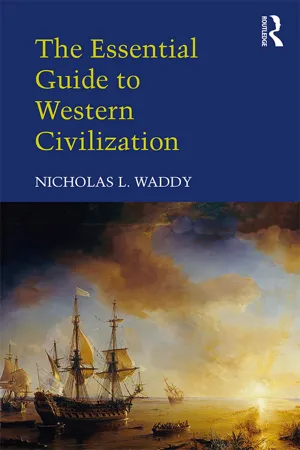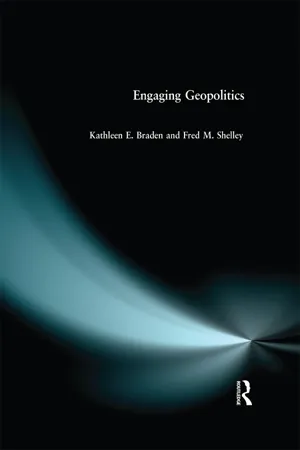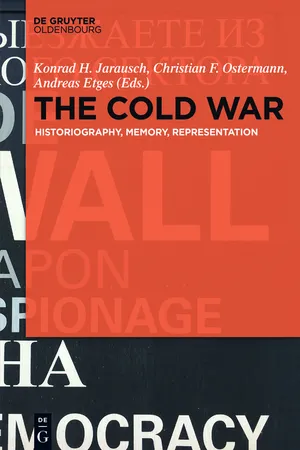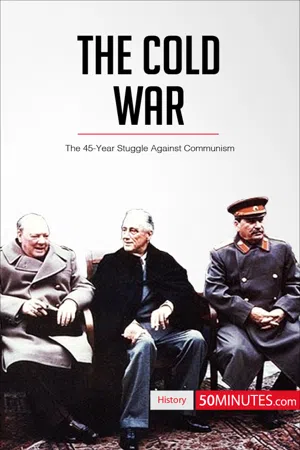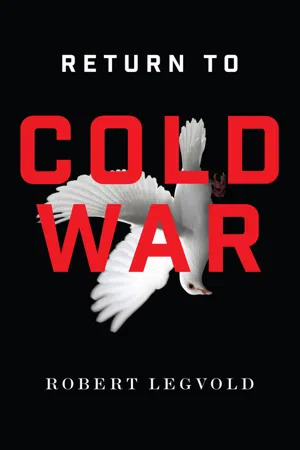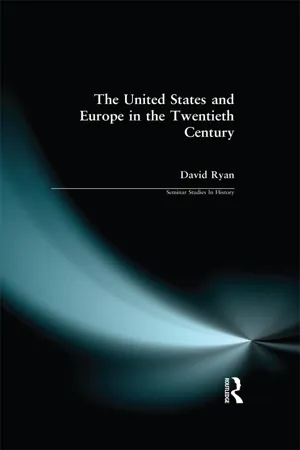History
Cold War in Europe
The Cold War in Europe refers to the geopolitical and ideological struggle between the Western bloc, led by the United States and its NATO allies, and the Eastern bloc, led by the Soviet Union and its Warsaw Pact allies, following World War II. This conflict was characterized by political tension, military build-up, and proxy wars, and it shaped the division of Europe into capitalist and communist spheres of influence until the collapse of the Soviet Union in 1991.
Written by Perlego with AI-assistance
Related key terms
11 Key excerpts on "Cold War in Europe"
- eBook - ePub
- William A. Pelz(Author)
- 2016(Publication Date)
- Pluto Press(Publisher)
CHAPTER THIRTEEN Europeans in the Cold War: Between Moscow and Washington The expression “cold war” has a long history. Used by the ancient Greeks, Spanish crusaders and popular into the twentieth century where it was employed by the likes of George Orwell and Winston Churchill, a cold war is when there is a state of conflict that stops just ever so short of direct military combat. Instead, the fighting mainly takes the form of economic competition, political maneuvers, propaganda and, at times, proxy wars between nations allied to one of the more powerful nations. It is a widely held belief that the post-World War II cold war started in 1946 or 1947 and was largely a result of Soviet aggression. As is so often the case, pinpointing the actual date and catalyst of conflict is not that simple. Some have argued that the Cold War started with Churchill’s welcome, but not acceptance, of the USSR as part of the anti-Hitler coalition in 1941. 1 Others have persuasively argued that the Cold War between Russia and the West actually started with the Bolshevik Revolution in 1917. What followed was the inevitable ebb and flow of relations between nations and rival social systems that were in fundamental contradiction. No matter the date, it is clear that relations between the Soviet Union and the Western powers were not the best for a number of years after the defeat of fascism in 1945. One theory put forward is that the division of Germany was not so much a result of the Cold War as a cause. Having been invaded twice by Germany in the first half of the twentieth century, the Russian government wanted a key voice in any post-war settlement. Failure of the USSR to reach agreement with the West, and vice versa, was a key source of tension. 2 This was part and parcel of the general move to cut the Soviets out of the post-war world. The US may have shared the atomic bomb with the United Kingdom but not with Russia - eBook - ePub
- Nicholas L. Waddy(Author)
- 2017(Publication Date)
- Routledge(Publisher)
19 The Cold War and the End of European Dominance, 1945–presentIntroduction
One of the great tragedies of the Second World War is that, for all the suffering it entailed, once it was over, oppression and the constant threat of renewed conflict persisted for many Europeans. Eastern Europeans were faced with Soviet occupation and with the replacement of their governments by communist puppet regimes. The entire world was threatened by the Cold War that emerged between the Western democracies and the Communist Bloc, led by the Soviet Union. The related threat of nuclear annihilation made the prospects for peace and stability look particularly dim.And yet Western nations and communist states avoided direct conflict, including nuclear war. The second half of the twentieth century was marked by dramatic improvements in the standard of living enjoyed by Europeans—and by most of the world’s people. The conclusion of the Cold War in 1989–91, and the collapse of communism in Eastern Europe and in its Russian heartland, paved the way for an end to the arms race and for the extension of democracy and capitalism to most of Europe’s people for the first time in history.Today, Europe is as free, peaceful, and prosperous as ever, but its role in the world is much reduced from the heady days of the nineteenth and early twentieth centuries. As this chapter and the Epilogue will make plain, Europe’s place in global affairs, and its relationship with the United States, will undoubtedly undergo further significant changes in the years ahead. Luckily, the study of European history can help illuminate the directions in which those changes are likely to lead.The Emergence of the Cold War, 1945–49
When Germany surrendered to the Allies, the future of Europe and the world as a whole was a subject of sharp disagreement. The Soviets intended to maintain control over Eastern Europe, and they believed that communist parties in Western European countries and in the Middle East would create opportunities for the further expansion of Soviet influence. The United States, Britain, and France, on the other hand, foresaw a world in which capitalist democracies would predominate. The Western Allies were divided in their opinions of European imperialism—the United States was decisively opposed—but they were united in urging the Soviets to respect the independence of all the countries of Eastern Europe. Nevertheless, none of the Western powers was prepared to fight yet another bloody war over the issue. In fact, initially it appeared that the United States might retreat into its traditional policy of isolationism and allow the Europeans to solve their own problems. One year after the end of World War II, the vast majority of American troops had been withdrawn from Europe. - eBook - ePub
- Kathleen E Braden, Fred M Shelley(Authors)
- 2014(Publication Date)
- Routledge(Publisher)
3The Cold War
KEYWORDS
blocs, domino theory, containment,détente ,glasnost, shatterbelt, non-alignmentKEY PROPOSITIONS
• New war-fighting technologies and the Soviet/American rivalry dominated post-World War II geopolitical discourse through the 1980s.• The locus of this conflict increasingly shifted to a third world stage and to four major shatterbelt areas.• Europe perceived itself as a buffer between two superpowers, a fact that helped the formation of a European Union.3.1 Introduction
The end of World War II in 1945 brought about substantial and profound changes in international relations. Since the Renaissance, the world economy had been centered in Europe, and geopolitical theory was concerned primarily with European states and their interrelationships. The conclusion of World War II signified that Europe was no longer at the center of the global political economy. After the war, the United States and the Union of Soviet Socialist Republics emerged as the world’s leading powers, while the countries of Europe were dependent on American and Soviet aid to rebuild their war-torn and devastated economies.Conflict between the Americans and the Soviets soon dominated geopolitical thought. Within a very few years, geopolitical and ideological differences between America and Russia were to divide Europe and initiate the Cold War. Sir Winston Churchill’s famous phrase, “an iron curtain has descended across the continent” came to symbolize Europe’s position in post-World War II geopolitics. Europe was no longer in a position to initiate geopolitical change; rather it was a potential battleground, both militarily and economically, between the competing interests of the United States and the Soviet Union. By the 1950s, Western Europe had become incorporated into the American-dominated North Atlantic Treaty Organization (NATO), and thousands of American troops were stationed in Germany and elsewhere in Europe with the intention of protecting Western Europe from potential Russian attacks. Similarly, the Warsaw Pact symbolized the incorporation of Eastern Europe into the Soviet sphere of influence. - eBook - ePub
- Konrad H. Jarausch, Christian Ostermann, Andreas Etges(Authors)
- 2017(Publication Date)
- De Gruyter Oldenbourg(Publisher)
404Nonetheless, in recent textbooks the old division continues to shape representations of the world in the long postwar period from 1945 to 1990. The binational German-French textbook titles its respective chapter “Europe in a Bipolar World (1949–1989)” and includes a conventional map with contrasting colors.405 Also, descriptions of the Cold War crises, the superpowers’ political and social systems as well as the division of Europe mirror the well-known structure of German and French books of the 1980s. The East-West conflict has become a leading term again, covering the whole postwar era which is divided into two or three phases, such as the “Cold War and Coexistence” or The Cold War proper (1945/48 – mid 1960s), détente (mid 1960s – mid 1980s), and reform and change (second half of the 1980s).406 In addition arguments already developed in textbooks of previous periods are repeated and become almost ubiquitous: “Mutual mistrust” led to a protracted conflict between the two superpowers. The “Cold War ... informed world politics for about 40 years.” However, the concept is still regarded as a “difficult” concept, needing further explanation. Histoire/Géographie poses the question: “What is the Cold War?” The answer refers to the action-reaction scheme and the calculation of limited risks. Each side multiplied provocations against the other side but tried to avoid open war.407The action-reaction scheme has become the leading explanatory paradigm. No longer is one side right and the other wrong, but both argue legitimately from within their own system of values. This kind of argumentation is most clearly deployed in English history textbooks. Walsh confronts U.S. and Soviet arguments during the Cuban Missile Crisis under the heading “Why was Cuba so important?” – for both sides. Pupils are encouraged to give “one reason why the USA disliked Castro’s government,” “one reason why Khrushchev put nuclear missiles in Cuba,” and “one reason why the USA objected.” Interestingly, the positions of the Soviet Union and Cuba are personalized and represented by Khrushchev and Castro respectively whereas Kennedy’s role is not mentioned as if U.S. public opinion were unanimous on the issue: “The USA was furious. It wanted to get rid of Castro quickly.”408 Clare et al. expressly ask “How close to war was the world in the 1960s?” and offer a surprising answer. Refering to latest research they state that it is some historians‘ “view of the Cold War, neither side had a single fixed agenda. Instead leaders stumbled through events. Often they did not fully understand what was going on: they were just trying to ‚come out on top‘.”409 - eBook - ePub
The Cold War
The 45-Year Struggle Against Communism
- 50MINUTES.COM(Author)
- 2016(Publication Date)
- 50Minutes.com(Publisher)
THE COLD WAR A CONFLICT THAT IS DIFFICULT TO UNDERSTAND It was in 1947 that the term “Cold War” was popularized by Bernard Baruch (1870-1965), a close advisor to Franklin Roosevelt. Through this term, he wished to highlight the existing tensions between the United States and the Soviet Union that, despite their intensity, could hardly lead to an armed conflict. Although many limit the Cold War to the years 1947-1991, the period starting with the implementation of opposing ideological doctrines – that of Truman and Zhdanov – and ending with the collapse of the Soviet Union, these dates are however arbitrary. The term “Cold War” indeed hides different meanings. In academic circles, some attribute the confrontation to the first years alone – the formation of the blocs – from the end of World War II to the death of Joseph Stalin, on 5 th March 1953. Others prefer to speak of this as the “First Cold War”, distinguishing the “Second Cold War” of 1979-1982, characterized by the further escalation of tensions. The Cuban missile crisis in 1962 is another milestone usually retained as marking the end of the conflict, as it was itself followed by a long phase of Détente. Finally, with regards to the ideological confrontation between Russian communism and American capitalism, it is sometimes more coherent to consider the Cold War to have started in 1917, when the Bolshevik Revolution began and faced the universalist aims of the US president of the time, Thomas Woodrow Wilson (1856-1924). The fall of the Berlin Wall, on 9 th November 1989, is often cited as the event that marks the end of the Cold War. In fact, this gave impetus to the gradual fall of the Sovietized regimes that disappeared definitively in 1991. More interestingly, one can hypothesize that the Cold War is still not truly over today, since Communist or related regimes (particularly in China, Cuba, North Korea) continue to cohabit in a capitalist world economy - eBook - ePub
- Robert Legvold(Author)
- 2016(Publication Date)
- Polity(Publisher)
Like any large, complex phenomenon, there are multiple ways to understand the Cold War. Two, however, help better than others to unscramble the tangle of interpretations vying to explain the new Cold War. The first is the venerable and widely accepted conviction that the Cold War was a battle between political and economic systems, underpinned by fundamentally different values, goals, and ontologies. Within this argument the principal contention was over the latter, over the ideological element, and whether it played a primary or secondary causal role. Less conspicuously, a second area of disagreement eventually emerged related to the primary sphere within which the inter-systemic rivalry took place. Scholars looking back over the whole of the Cold War charged that mainstream analysts, particularly international relations theorists, had gotten it wrong by stamping it Euro-centric – that is, as a strategic contest between the United States and the Soviet Union over the fate of the international system’s European fulcrum – when, in fact, the Cold War’s active theater was the Third World (Westad, 2007).If the Cold War, as Fred Halliday (1999) argued, was as much a socio-economic contest for the hearts and minds of much of the globe as an ideological and geopolitical test of wills, then the fluid environment where it raged and, indeed, the point from which it ricocheted back into the anxiety-ridden consciousness of US and Soviet leaders was the vast expanses of a roiling postcolonial world. Halliday, to put a fine point on it, suggested that US “national security doctrines – from Truman to Reagan – were less about responding to Soviet geopolitical maneuvering and more concerned with responding to the geopolitical consequences of localized revolutionary crises” (Saull, 2011).That was inside the argument. Outside of it, the opposing school insisted that the clash of political and economic systems mattered less than a simple, classical slugfest over power. The clash was merely the tissue covering the real muscle controlling events. Beginning with this elemental argument, all of these contested byways echo today. Thus, some argue that the trouble traces back to the wildly different assumptions motivating the two sides. From the Western perspective, everything begins with the red in tooth and claw determination of Russian leaders to reverse the loss of place and power following the collapse of the Soviet Union. From a Russian perspective, the root cause is in the (unexplained) determination of US leaders to diminish Russia and put it in a box. It is a simple struggle for power, and these are its terms. - eBook - ePub
International Relations since 1945
East, West, North, South
- Geir Lundestad(Author)
- 2017(Publication Date)
- SAGE Publications Ltd(Publisher)
2 The Cold War in Europe, 1945–1949Political Science and History
In political science the study of international relations has been dominated by two basic general approaches, realism and liberalism. Realism was long the dominant approach. Its starting point was the anarchic nature of the international system, in the sense that the predominant consideration of each state was to protect its own security. You could never be certain what other states would do in the future. Therefore you had to prepare for the worst contingencies. In a world of sovereign states, international institutions mattered only on the margins. The international community differs from the domestic situation within individual nations in that there is no effective central power having more or less a monopoly of the use of force.No state was really willing to leave its primary security requirement to an international authority. The United Nations could perform some useful functions, but the Great Powers all insisted on having a veto to stop the new organization from undertaking actions contrary to their interests. The Soviet Union came to use its veto quite frequently. Since the Western powers dominated the UN, they long had less of a need to use their vetos.Conflicts are therefore inevitable in the international system. The normal state is rivalry rather than cooperation. Of course major powers can cooperate, but when they do so it is most often to face a joint threat. When the threat no longer exists, cooperation normally dissipates. In this perspective the antagonism between East and West is a new variation on a familiar theme. The coalition between the United States, the Soviet Union, and the United Kingdom was dissolved after Germany and Japan were defeated in 1945. A similar situation pertained after the Napoleonic wars and after the First World War. But the objection can be raised that the tension between East and West after the Second World War reached a higher level than after earlier, corresponding conflicts. - eBook - ePub
War, Peace and International Relations
An introduction to strategic history
- Colin S. Gray(Author)
- 2013(Publication Date)
- Routledge(Publisher)
Why was it so difficult for the West to make peace with the Soviet Union (and vice versa)? Why did the Cold War endure for more than forty years? One could cite geopolitical rivalry, the key roles of individuals, and contingency, but pride of place needs to be accorded to ideology. The evidence strongly suggests that the Cold War could not end until the Soviet Union abandoned a state ideology which mandated definition of capitalist powers as enemies. When Gorbachev retired the ideology, the Cold War was over. Unfortunately for him, though, the abrupt retirement of Marxism to the dustbin of history also removed the basis for the legitimacy of the Soviet state. It may be worth noting that, at the time of writing (slightly more than a decade into the twenty-first century), the People's Republic of China has not renounced its legitimizing political ideology, yet that legacy (or burden) from the past is not a noteworthy player in contemporary Sino-American security relations. The master narrative of global international relations has to accommodate significant variations from historical case to case.The story now must turn to consider explicitly the meaning of the nuclear discovery and the implications of the subsequent strategic revolution.Key points- Cold War history is hotly contested today.
- World War II had revolutionary consequences for all the contexts of international relations.
- The Cold War emerged slowly, by a process of interaction between rivals, from 1944 until 1947, or even 1950 (the war in Korea).
- Because of geopolitics, ideology and personality (especially Stalin's), the conflict was unavoidable.
- The Soviet Union was fatally outclassed in economic strength by the United States.
- Although it was inevitable that the Soviet Union would lose the competition, it was not inevitable that it would accept such defeat peacefully.
Questions- Who or what caused the Cold War?
- Why did the Cold War last for forty years?
- Why did the Cold War not conclude with World War III?
- Did the Soviet Union expire mainly for internal reasons or was external pressure an important factor?
Further reading
G. S. Barrass, The Great Cold War: A Journey through the Hall of Mirrors (Stanford, CA: Stanford University Press, 2009).R. Crockatt, The Fifty Years War: The United States and the Soviet Union in World Politics, 1941–1991 - eBook - ePub
Western Civilization: A Global and Comparative Approach
Volume II: Since 1600
- Kenneth L. Campbell(Author)
- 2015(Publication Date)
- Routledge(Publisher)
With democracy weakened, the church struggling to play a significant role in Latin American life and undecided on what that role should be, and a growing divide between rich and poor, it is perhaps no wonder that military governments came to play the most important role in Latin American politics in the postwar era. Increasing industrial and agricultural production allowed cities to grow, but they grew so rapidly that they overwhelmed the capacity of government or society to deal with the housing and sanitation problems that resulted, much less to guarantee full employment for everyone. Still, some countries did experience democracy during this period, including Brazil until 1964 and Peru, Venezuela, and Colombia after 1958. The major consequence of the Cold War period, ironically, was the inability of the United States to promote democracy in this region while at times even undermining it in order to prevent socialists from taking power; the real rise in democracy in Latin America, in fact, has come since the end of the Cold War in 1989.Conclusion
Decades later, the 1950s would be remembered as a particularly stable time in history, before the turbulence and radical changes that accompanied the 1960s. Those who were alive in 1959 may not have shared that view. Europe had largely recovered from the catastrophe of World War II, but not by returning to some stable status quo such as was attempted by European leaders at the Congress of Vienna in 1815. Instead, European leaders looked forward by initiating greater levels of cooperation among nations than ever before. In addition, nations in both Eastern and Western Europe joined alliances that were intended to provide a measure of security but that in fact contributed to the growing insecurity of the Cold War and the nuclear age. In 1956 the Suez crisis almost led to an Arab-Israeli war and threatened to destabilize great power relations. The Middle East had clearly become a focus for Arab and Israeli nationalism, as well as of growing interest to the West because of its abundant oil supplies. Soviet intervention in Hungary and Poland that same year brought about another Cold War crisis. The Cuban Revolution started to inspire radical politics among the youth of Latin America and, to some extent, in the United States itself. In 1959 the Cuban Revolution succeeded and Castro assumed power. The United States attempted to overthrow Castro within a year, pushing Castro further in the direction of communism and alliance with the Soviet Union. The United States sent forces into Lebanon in 1958 and started to become involved in the political situation in Vietnam when French influence collapsed there in the mid-1950s. Communism was still perceived as a real threat that needed to be stopped, despite the fall of McCarthy, whose political antics had done much to destabilize the early part of the decade for many people. The 1960s would be such a turbulent decade in large part because of a combination of explosive issues and developments that arose in the previous decade. - David Ryan(Author)
- 2016(Publication Date)
- Routledge(Publisher)
Eastern Europe was central to the origins of the Cold War. The Soviets quickly asserted their influence after the war. By 1948 Czechoslovakia, Poland and East Germany were generally under their control. These areas were not of intrinsic value to the United States, though they were of essential value to the West European economies and that in turn made them essential to the US economy. This situation, coupled with the Soviet insistence that Eastern Europe acted as a buffer zone from attack from the West, eventually led to a forty-five-year Cold War. The immediate Soviet threat to the United States was negligible. Soviet policies were ‘confused and contradictory … the links between the Kremlin and the Communists abroad were intermittent and inconsistent’, but Washington feared the connections between the Soviets and communists in Western Europe, as well as their control over Eastern Europe (Leffler, 1992: 5–7).Such fears, misperceptions and wilful misrepresentations deepened the atmosphere of Cold War. Throughout 1946 attitudes hardened and compromise became increasingly difficult. By the end of the year the Soviets were pressurising Turkey on access and influence over the Dardanelles. In Greece, the British too claimed Soviet interference and the US aid mission to Greece reported on the possibility of the Soviets extending their influence into the Mediterranean either directly or through the use of insurgents. Most historians agree that the Soviets were not supplying the Greek insurgents and that the latter had limited ties to Moscow. It is an historic irony of vast proportions that Stalin had mostly kept to his percentage agreement with Churchill on Greece; it was Yugoslavia’s Josep Broz Tito, the communist president, who was supplying the Greek insurgency. Nevertheless, the myth of a monolithic communism prevailed because within the mindset of official Washington, Truman believed that ‘all communists took their orders from Moscow’ (Paterson, 1995: 71).- eBook - ePub
Europe and America
The End of the Transatlantic Relationship?
- Bindi(Author)
- 2019(Publication Date)
- Brookings Institution Press(Publisher)
PART II The Cold War Superpowers in a Hot WorldPassage contains an image ELEVEN Russia’s Staunch Foreign Policy in a Wavering Landscape SERENA GIUSTI
F or centuries Russian foreign policy has been marked by expansion, militarization, and border defense. The identity of Russia itself has been forged by the country’s capacity to spread out and conquer new territories. While Russia under the czars was long one of the key players in European diplomacy (and also had a strong interest in expanding eastward), under Soviet rule it became a superpower whose ideological and geopolitical influence extended throughout the world. Soviet foreign policy took on a global dimension due to the bipolar nature of the international system, within which Russia and the United States struggled for dominance. The system revolved around the two superpowers, and it relied for its survival on the doctrine of nuclear deterrence based on mutual assured destruction. There were, however, several shifts in alliances as some countries passed from one sphere of influence to the other; other countries were able to maintain nonaligned status.The Kremlin, following the centuries-old strategic logic of Russian imperialism, kept strict control over the Eastern European countries (the so-called satellites) in order to use the region as a buffer against possible military attack by the major Western powers.1 Unlike other empires, the Soviet Union did not fall because it was defeated in war but because the political and economic model on which it was based failed. The bipolar system crashed after the satellites rejected the Soviet legacy for full sovereignty, and the Soviet Union itself imploded quite unexpectedly.Even the international relations theory of realism failed to forecast the end of the rivalry between the great powers, the unilateral Soviet withdrawal from its sphere of influence, and the rise of nationalism. Russia no longer controlled an imperial hinterland in Europe, and it no longer was confronted with a zero-sum relationship with the United States. As Ilya Prizel pointed out, “Within the short space of three years the Russian people have seen the ideology that dominated their polity for seven decades de-legitimized. Worse still, they have lost the vast territories that for centuries [they] considered their own and have witnessed the disappearance of an imperial status that has been part and parcel to Russia’s national being since at least the sixteenth century.”2
Learn about this page
Index pages curate the most relevant extracts from our library of academic textbooks. They’ve been created using an in-house natural language model (NLM), each adding context and meaning to key research topics.

